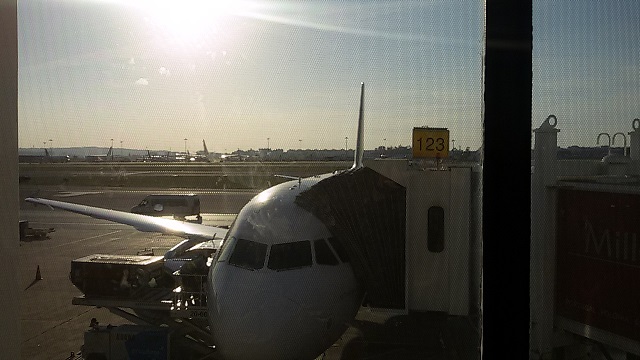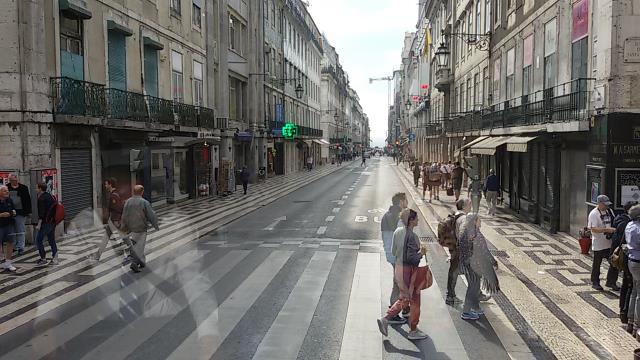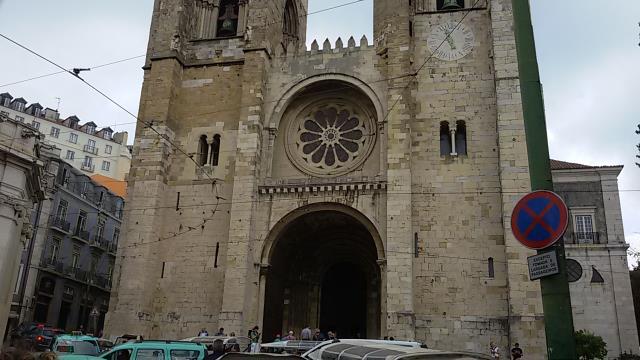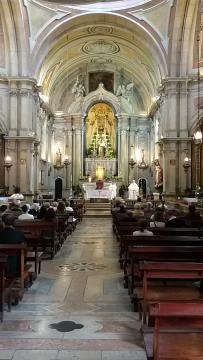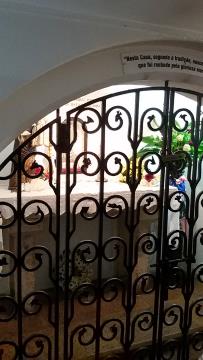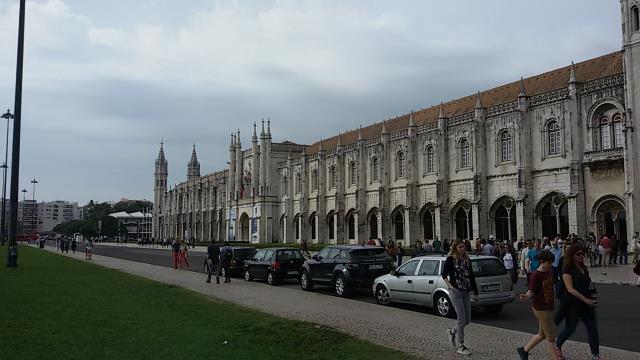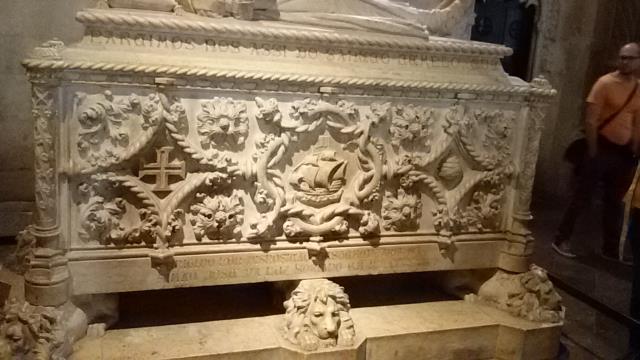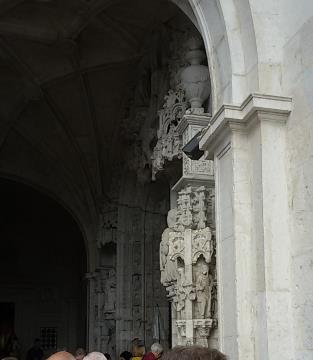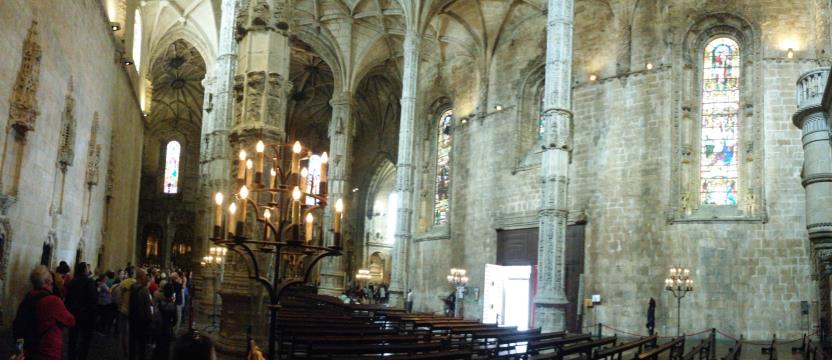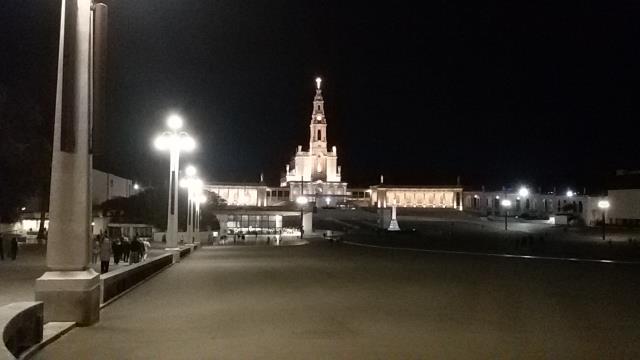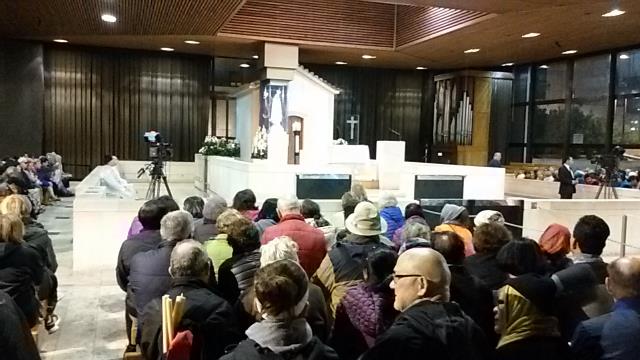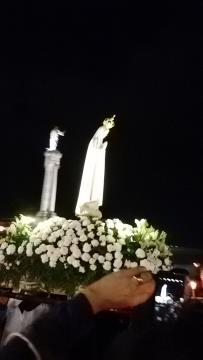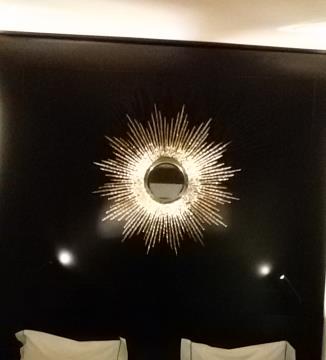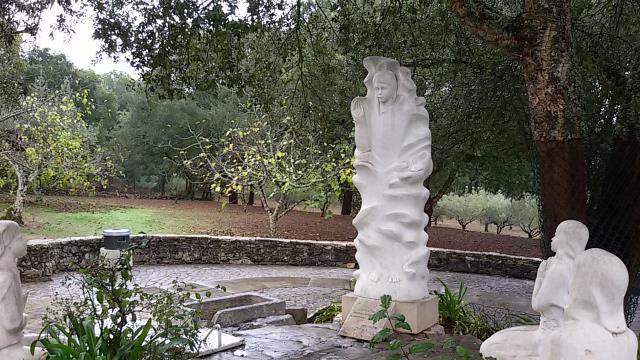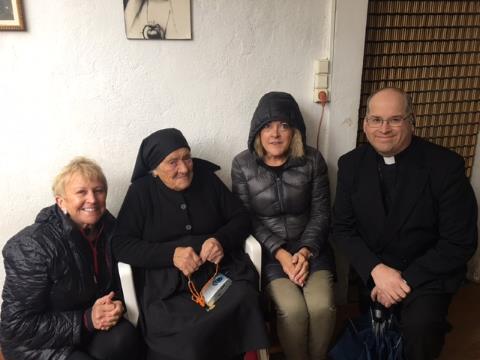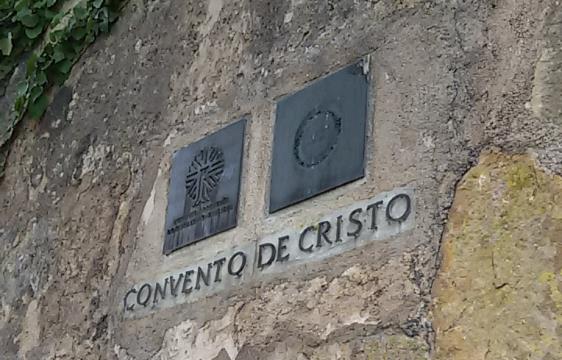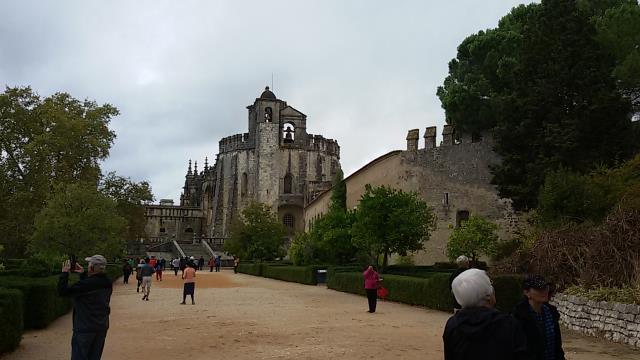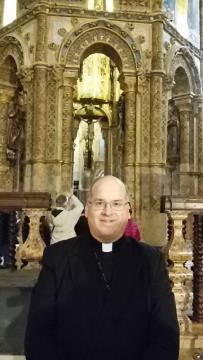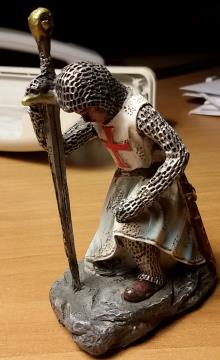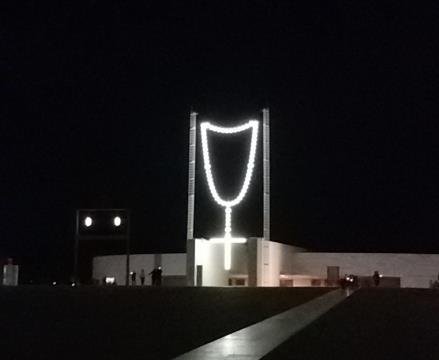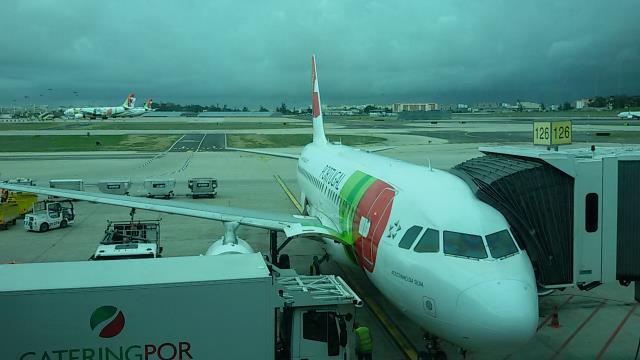Some opportunities drop out of Heaven. While I was at St. Brendan the Navigator parish in Cumming during the summer the pastor, my brother priest and Legionary Fr. Matthew Van Smoorenburg, asked if I could cover for him as chaplain at the start of a parish pilgrimage that would be visiting Portugal, Spain, and France, since I’d already be in Europe. Twist my arm… I’d have an opportunity to visit Portugal and, especially, Fatima for the first time. My home parish (Our Lady, Help of Christians in Watsonville, CA) has a large Portuguese community and a beautiful statue of Our Lady of Fatima, one of my favorite depictions of Our Lady. As I was preparing to enter the seminary I’d often pray in front of that statue. So after requesting the proper permissions and the okay from my dean (since the semester and classes were underway), I spent October 31st to November 3rd in Portugal.
October 31st: departure for Lisbon
After giving class in the morning on October 31st I headed by train to Fiumicino airport for the flight to Portugal, arriving with no problems. A couple sitting next to me didn’t say a word, but their faces lit up when they saw I would sit with them and the wife gave me a thumbs up when we left the plane and a smile.
I arrived at the hotel in Lisbon as the sun was setting. The pilgrims were receiving an orientation talk by our pilgrimage guide, Jorge. I was happy to see more than one familiar face in the group, since I’d spent the summer saying Mass at the parish. It was a little surreal staying in a hotel again. I hadn’t stayed in a hotel in over twenty years (and a motel in over ten), but if anyone knows European hotel rooms they’re not much bigger than my normal accommodations at home (small, that is). The biggest difference was a TV and remote strategically positioned to be viewed from bed. I didn’t use it; other than sleeping, my hotel time was brief and consisted of catching up on my blogs and prayers before bed. Jorge had recommended trying bacalhau (salted cod fish), since the Portuguese considered it a staple dish with lots of ways to prepare it, and at dinner I tried some and loved it. The irony was that Croatians also go crazy over a stew made from salted cod fish called bakalar that my parents never let me try because they said it was an acquired taste and didn’t want to waste it on me. In California, for my parents’ restaurant, we’d travel down to San Pedro to purchase it because it was imported.
November 1st: All Saints, Lisbon, Santerem, and Fatima
The next morning we spent touring Lisbon. As our plane came in for a landing the previous afternoon I was struck by the uniformity and clean lines of Lisbon’s architecture. Our guide explained that the city of Lisbon had been largely destroyed in an earthquake in 1755 (on All Saints, 262 years to the day), and the reconstruction was so massive that the streets were laid out with great symmetry and the buildings reconstructed en masse using veritable factories of production materials.
Cathedral La Sé and birthplace of St. Anthony of Lisboa (a.k.a. of Padua)
We visited the cathedral La Sé (short for the Latin Sedes Episcopalis–see of the bishop). St. Anthony of Padua (from Lisboa, actually–ask a local and they’ll tell you) was baptized at the cathedral. I learned a local tradition of devotion to Saint Anthony that I’d never heard before: women who wanted to get married. At one point the women would tie their hair into a pony tail and cut it off, leaving it as a sign of an ex voto (a token showing that St. Anthony had answered their prayer–in Marian shrines, for example, some people leave silver hearts). It’s not done anymore, but, at the time, a women with shorn hair was considered a woman of ill repute, so it was a way of showing humility regarding what people thought of you and your reputation.
A short walk from the cathedral was the Church of St. Anthony, built on the spot where he was born and raised. It was a beautiful church. It too was destroyed by the 1755 earthquake, and the children of Lisbon went throughout the city raising funds for its reconstruction. Considering how beautiful it is, they were very successful and people were very generous.
St. Anthony is an example of how God uses everything you have to accomplish his will. At first St. Anthony went to the Abbey of Santa Cruz in Coimbra, the capital of Portugal at the time, and studied theology and Latin. It was only later that he decided to become a Franciscan after being struck by their joy and witness. As a Franciscan he traveled to Morocco, inspired by the example of the Franciscan martyrs, but fell sick and, on the way back to Portugal ended up Sicily when the ship was blown off course. From there he went to Tuscany and stayed, become known as il Santo (the Saint) by the Paduans. St. Francis of Assisi was still alive, and not convinced of the need for the friars to do studies, but, after St. Anthony was asked by his abbot to preach a homily at the last minute, he showed his eloquence and intelligence and the friars started studying under his tutelage. If not for his talents the Franciscans may have never gotten into theological studies.
Mosteiro dos Jeronimos monastery, Lisbon
After some more touring by bus we arrived at the Mosteiro dos Jeronimos (The Hieronymite monastery). The monastery once housed the Hieronymites, an order of monks, dedicated to the Biblical scholar and translator St. Jerome. From laying the foundation to completion took around a hundred years (the original plan was eight, but when the taxes they’d levied for its construction swelled they expanded their plans). Being close to the harbor this monastery also became a hub for Portugal’s great exploratory achievements. The great Portuguese explorer Vasco de Gama is buried in the chapel.
The monastery was originally commissioned by King Manuel I, who had entrusted the monastery to the Hieronymites and asked that they continue to pray for him, even after his death. Given the great achievements of the Portuguese in this period it seems their prayers were answered. The monastery also showed artistic embellishments called the Manueline style, named after King Manuel I, containing many elements of sea travel and exploration.
The monks also concocted a pastry, the Pastel de nata, and solemnly entrusted the recipe to a nearby bakery, now famous, called the Pastéis de Belém (named after the district). I can attest that the pastry is heavenly (note the lower case to avoid idolatry…).

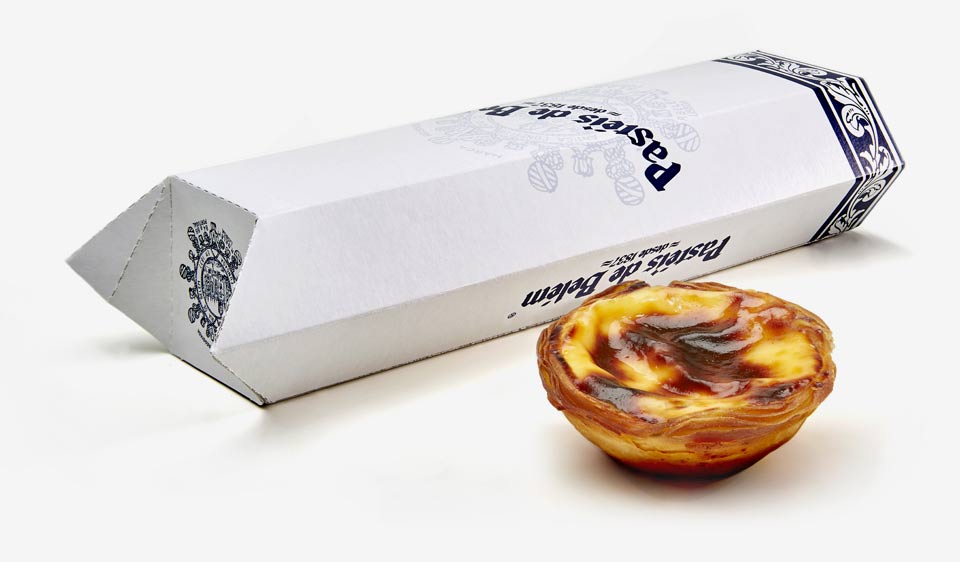
Mass and the Eucharistic miracle at Santerém
After lunch we departed for the town of Santerém (forty-five miles north of Lisbon) to celebrate Mass at the Igreja do Santissimo Milagre (Church of the Holy Miracle) and see a Eucharistic miracle from the thirteenth century. We celebrated the Mass for All Saints, and in my homily, my first opportunity to preach to the pilgrims, I told them that pilgrimages were a reminder that the Pilgrim Church on earth is always on pilgrimage, headed toward the Promised Land of Heaven. Our pilgrimage was simply a more intense part of that journey to sainthood, the sainthood every soul in Heaven has achieved by God’s grace and to which we are all called. If we on earth are part of the Pilgrim Church, in Heaven we’ll join the Church Triumphant: one Church, two states of life within her. All Saints celebrates all the saints, anonymous and otherwise, who are now in Heaven, helping us and awaiting us.
Now for the Eucharistic miracle (source). A woman faced with an unfaithful husband decided to consult a sorceress to see how she could win him back. The sorceress demanded a consecrated host as payment (which is sacrilege, for those who don’t know), so the woman took one at Mass in the Church of St. Stephen and hid it in a veil. As she left the church, with the host hidden and held to her chest, the host started to bleed and people tried to help her, thinking she had cut her hand. She ran home in a panic and threw the bloody host into a trunk. Her husband did not come home until late. In the middle of the night they were awoken by a strange light coming from the trunk. The woman confessed to her husband what she had done and they both knelt in repentance before the miracle.
A priest sealed the miraculous host in wax and returned it to the church, placing it in the tabernacle. When he later opened the tabernacle he discovered the wax in pieces and the host enclosed in a crystal pyx. The crystal pyx is now on display in a silver monstrance, with a smaller reliquary containing the wax. We were allowed to spend a moment up close looking at both (from an area behind the one you see in the photo below), and you could see the dried blood around the host. No photos were allowed, but it was a moving reminder of what a miracle the Eucharist is every day.

First arrival at Fatima
After Santerém we continued on to Fatima. It was dark by the time we arrived, but that didn’t deter us from going to the shrine right after dinner. I won’t recall everything that happened at Fatima; EWTN has a wonderful site dedicated to the topic, and I read excerpts of it to the pilgrims when we were travelling by bus. Walking into the shrine reminded me of the first time I’d seen Saint John the Paul II in person: surreal. I couldn’t believe I was actually in Fatima and at the shrine. On one of John Paul II’s visits there I watched the procession with that same image and hoped I could participate some day. Now I had my chance. That evening we attended a rosary in the Chapel of the Apparitions (the spot where Our Lady appeared), which included a candlelit procession with the statue of Our Lady in the plaza. On Facebook I asked for prayer intentions and tried to bring them all before Our Lord in the Eucharist and Our Lady.
We stayed at a new hotel that new how to cater to its clientele. There was a picture of Pope Francis at the reception desk, a shop selling religious articles, and in my room there was a Eucharistic motif to the headboard of my bed. There were pilgrimages staying their from Ireland and Africa as well.
November 2nd: All Souls, Tomar and Fatima
The next day I concelebrated in an English Mass at the Chapel of the Apparitions. In the chapel there is a statue of Our Lady on the exact spot where she appeared. After distributing Communion I walked right past it to put the ciborium back in the tabernacle and it was incredible.
After Mass we went to visit the homes of the children to whom the Blessed Mother had appeared. When the children started seeing apparitions it began with an angel who later revealed himself to be the Guardian Angel of Portugal. We visited that spot and I also had the unexpected grace to meet a relative of Suor Lucia. She was gracious enough to let us pose for photos with her. I gave her my priestly blessing afterwards and she smiled and reverenced my hands. According to our guide she was almost a hundred years old.
Tomar and the castle Convento do Cristo
After a lunch and shopping break we headed to Tomar to visit the Convento do Cristo (the Convent of Christ), a castle that was the see of Templar power in Portugal from the XII century to the XVI century. The Knights Templar (their full name is the Poor Fellow-Soldiers of Christ and of the Temple of Solomon–since in the Holy Land their headquarters resided on the ruins of the Temple) resisted a Moorish invasion and Christianized the region, then later funded the great exploratory push of Portugal. They were entrusted with the entire Tomar region. History buffs at this point might point out that the Templars were dissolved in the XIV century after being subjected to a smear campaign that had the intention of confiscating their assets and property. That is true, but Portugal was so favorable to them due to their help in the Reconquista that in Portugal they were re-founded as the Ordem dos Cavaleiros de Nosso Senhor Jesus Cristo (Order of the Knights of Our Lord Jesus Christ) and “inherited” the same assets and property with the blessing of Portugal’s king and Pope John XXII.
I was really struck by my visit to the Convent (castle), and not just because I am a medieval enthusiast. Hearing their history, their accomplishments, and their trials, I couldn’t help thinking about how similar the names “Knights of Christ” and “Legionaries of Christ” are. At one point our motto was “contemplative and conquering,” and expression now mitigated a little to “contemplative and evangelizing” (to be honest, I prefer conquering). While not denying that our Founder did some reprehensible things, things that did require a deep institutional review on our part and reform, it’s also true that some would accept nothing less than our complete dissolution. On my last visit home someone at the parish told me exactly that. It’s obvious that I disagree, but the important thing is that the Holy See does too, or else I’d be the first to pack my bags. Some despicable things really happened in the Legion, but some accusations are untrue.
The Knights of Christ gave not only spiritual, military, and financial support to Portugal, but cultural support as well, bringing resources from the Holy Land without which the great exploratory endeavors of the Portuguese would not have been possible, such as maps the Western world had not yet drafted. Evangelization is not just directly spiritual; it is also meant to transform individuals, societies, and cultures from within. That may no longer require swords, armor, and castles, but it does require a spiritual militancy that is willing to fight for and defend not just the truths of the faith, but the truth itself using whatever morally acceptable means are available. As Legionaries we take up that battle too. A pilgrim was kind enough to buy me a little miniature of a Knight of Christ, kneeling to pray while resting on his sword, to remind me that I too must always fight on behalf of Our Lord. When we were in the gift shop looking over the knight miniatures I pointed out the praying knight right away, and I’m glad to say that a few men on the pilgrimage followed suit by buying it too. I keep it on my desk now, near my computer, but pointing toward a portrait of Christ in my office to motivate me whenever I get an attack of laziness.
All Souls
Since it was All Souls day I took advantage of our bus trips to remind the pilgrims of the important of praying for the souls in purgatory. I explained indulgences and how to get them. If you want a recap of the importance of All Souls Day and praying for the souls in purgatory see my homily for All Souls Day. Part of the traditions of All Souls Day is a visit to the cemetery to pray for the dead. This year I prayed at the tombs of Templar Knights in the Convent of Christ. One of my brother priests also had just lost his dad to cancer, and I was happy to tell him via Facebook that I would remember his father in my Mass and during the pilgrimage.
Eucharistic Procession
We returned to Fatima and after dinner I decided to visit the shrine one last time and participate again in the procession. Since it was Thursday the procession would be with the Eucharist, and the Rosary would include Exposition and Benediction at the end. Right up my alley. I’d discovered the night before that priests could vest in alb and stole to sit in the sanctuary during the rosary and then process with the Blessed Sacrament, so this time I did. As I was vesting a priest entered who looked very familiar: it was a fellow Legionary priest, Fr. Oswaldo Verdín, who was with a pilgrimage of Brazilian Regnum Christi members. What a Godincidence. He did the Exposition and Benediction. On my first day in Fatima I missed the pastor of my home parish (Our Lady, Help of Christians) by only a few hours, who’d already been in Portugal for a few days with his group.
November 3rd; Back to Rome
As the pilgrimage continued to Spain I returned to Lisbon and flew back to Rome after three unforgettable days.

